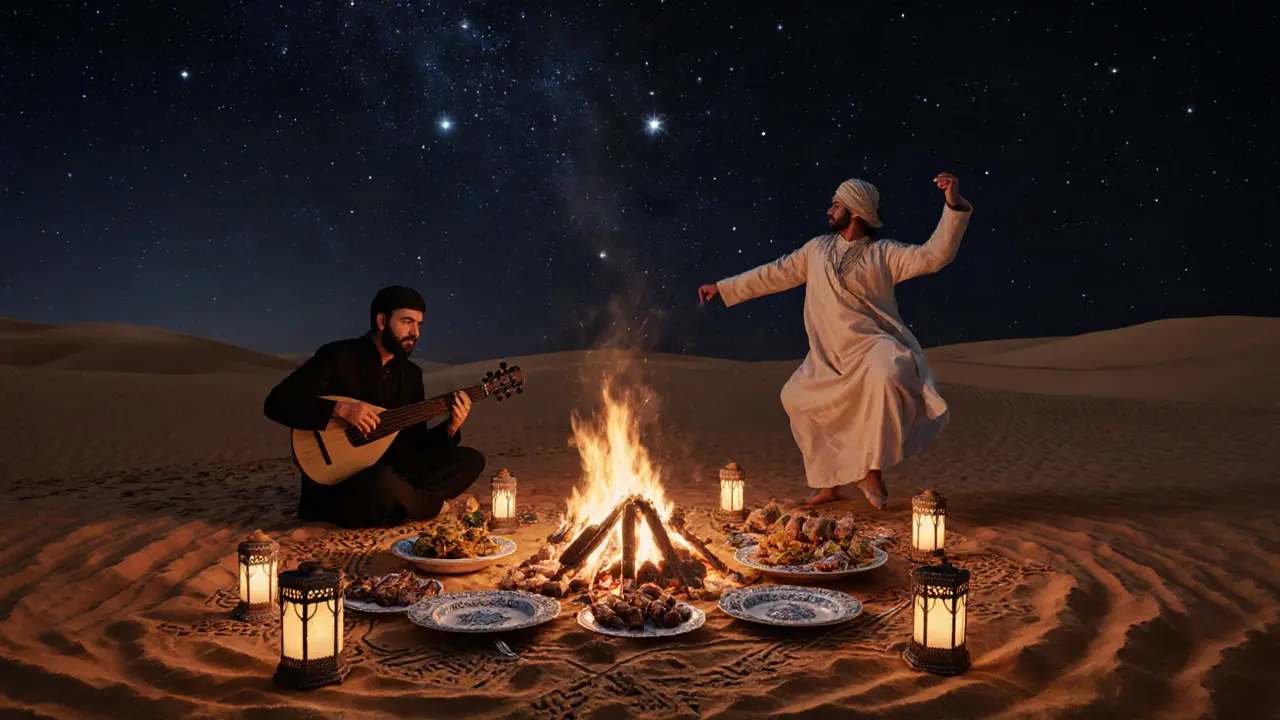
When the sun dips low over the Dubai desert, the sand turns gold and the silence becomes something you can feel. This isn’t just a ride through dunes-it’s a walk through centuries. Desert safari adventures in Dubai aren’t just tourist traps with quad bikes and shisha. They’re a living connection to a landscape that shaped empires, silenced armies, and taught survival to those who dared to cross it.
What Makes a Desert Safari More Than Just a Ride?
Most people think desert safaris are about speed-dune bashing in a 4x4, tires kicking up clouds of sand, hearts pounding as the vehicle climbs a 60-degree slope and drops into the valley below. That’s part of it. But the real magic happens when the engine turns off.
Picture this: you’re sitting on a rug spread over warm sand, the last light catching the tips of the dunes. A Bedouin elder pours cardamom coffee from a long-spouted pot. The scent of frankincense drifts from a small burner nearby. No music. No chatter. Just the wind. This moment isn’t staged. It’s inherited. The same silence, the same ritual, has been passed down for generations.
Modern safaris mix old and new. You’ll ride a camel like a trader did 500 years ago, then hop into a luxury SUV that can handle the same terrain. You’ll eat grilled lamb cooked over an open fire, just like Bedouin families once did, but now it’s served on fine china with a side of Arabic bread baked in a traditional tandoor oven.
The Real History Beneath the Sand
The desert around Dubai wasn’t always empty. Archaeologists have found ancient tools, pottery shards, and even the remains of freshwater springs buried under dunes. These weren’t just resting spots-they were lifelines. Nomadic tribes moved with the seasons, following water and grazing land. The desert wasn’t a barrier; it was a highway.
By the 19th century, the Al Maktoum family ruled Dubai from a small fort near the creek. Their wealth came from pearls, traded across the Gulf. Dhow boats carried them to India and East Africa. But the pearl trade collapsed after Japan perfected cultured pearls in the 1920s. Many families turned to the desert-hunting, herding, trading salt and dates. The desert didn’t abandon them. They learned to read its rhythms: where the wind carried moisture, where the sand shifted to reveal hidden springs, how to track scorpions by their footprints at night.
Today, you can see traces of that history. Some safari operators still use traditional navigation techniques-reading the stars, feeling the wind’s direction, noticing how the dunes align. These aren’t tricks. They’re survival skills, refined over centuries.
Dune Bashing: Why It’s Not Just Thrill-Seeking
Dune bashing isn’t reckless driving. It’s precision. A skilled driver knows how to read the slope of a dune before climbing. Too steep? The vehicle stalls. Too shallow? You lose momentum. The best drivers don’t just follow a route-they feel the sand. They adjust speed, gear, and tire pressure based on the texture beneath them.
Modern safari vehicles are built for this. Most use modified Toyota Land Cruisers or Land Rover Defenders with reinforced suspensions, locking differentials, and oversized tires. But the real secret? The driver. Many have spent years working in the desert-some since they were teens. They don’t just know the terrain; they know how the sand behaves after rain, how wind patterns change at dusk, where the soft patches hide.
And yes, the drop-offs are real. A 40-foot descent feels like freefall. But the vehicles are designed to handle it. The roll cages, seatbelts, and padded interiors aren’t just for show. In 2023, Dubai’s tourism authority mandated that all safari operators pass a safety certification. Drivers must complete a 40-hour training course covering emergency response, first aid, and terrain navigation. It’s not just about fun-it’s about responsibility.

Camel Rides: The Slow Way Through Time
If dune bashing is adrenaline, camel riding is meditation. These animals are built for the desert. Their wide feet don’t sink. Their humps store fat, not water. They can go days without drinking. And they move with a rhythm that’s hypnotic-left, right, left, right-like a slow heartbeat.
Many safari tours now offer sunset camel rides. You’re guided by a Bedouin handler who speaks little English but shows you everything with gestures. You’ll pass old trading routes, now marked by stone cairns. You’ll see where Bedouin women once gathered to weave wool into tents. You’ll hear the jingle of camel bells, a sound unchanged for 2,000 years.
Don’t expect a gentle trot. Camels rise and fall like a rocking chair. First-timers often grip the saddle too tight. The trick? Relax. Let your body move with theirs. It’s not about control-it’s about surrender. And that’s the point.
The Evening Ritual: Fire, Food, and Folklore
As darkness falls, the desert comes alive in a different way. Campfires crackle. Strings of lanterns glow orange against the black. A live oud player begins a slow melody. A dancer in traditional attire moves to the rhythm, her movements telling stories of desert storms, lost caravans, and love songs sung under the stars.
The food is simple but powerful. Grilled kebabs, slow-cooked harees (a wheat and meat porridge), and sweet luqaimat (dough balls drizzled with date syrup). Everything is cooked outdoors. The smoke from the fire doesn’t just flavor the meat-it carries the scent of the desert itself: dry earth, wild thyme, and the faint salt of ancient seabeds.
Some camps still tell stories. Not the scripted ones you see on Instagram. Real ones. About the time a sandstorm buried a caravan for three days. About the Bedouin woman who found water by following the flight of a desert hawk. About the stars that guided traders home when there were no roads.

What to Bring-and What to Leave Behind
You don’t need much. But what you bring matters.
- Light, loose clothing-cotton or linen. Avoid dark colors; they trap heat.
- A scarf or shemagh. Not just for style-it protects your face from blowing sand.
- Sunglasses and sunscreen. The sun reflects off the sand harder than you think.
- A small bottle of water. Even if your tour says drinks are provided, having your own is smart.
- A phone with offline maps. Some areas have no signal, and you’ll want to remember where you were.
Leave behind: high heels, heavy backpacks, and expectations of luxury resorts. This isn’t a hotel. It’s the desert. Respect it.
When to Go and How to Choose a Tour
November to March is the sweet spot. Days are warm but not scorching. Nights are cool enough for blankets. Avoid July and August-temperatures can hit 50°C (122°F). Even the camels slow down then.
Not all tours are equal. Look for operators who:
- Use certified drivers (ask to see their license)
- Offer small group sizes (under 10 people)
- Include cultural elements, not just rides and food
- Have clear safety briefings
- Don’t push you to buy extras at the end
Some of the best experiences come from family-run operators. Ask locals. Check reviews that mention the driver’s name or the camp’s location-not just “awesome ride.” Real stories stick.
Why This Experience Endures
Dubai has skyscrapers, malls, and artificial islands. But the desert? It’s still wild. It doesn’t need to be marketed. It doesn’t need to be fixed. It just is.
People come for the thrill. They stay for the stillness. They leave with something they didn’t expect: perspective. The sand doesn’t care about your job, your phone, your status. It’s older than all of it. And in that silence, you remember what it means to be small-and alive.
Is desert safari safe for children?
Yes, most desert safaris welcome children over the age of three. Many operators offer family-friendly tours with slower dune bashing, shorter camel rides, and kid-friendly meals. Always check the minimum age requirements and ask if the vehicle has child seat anchors. Avoid evening tours with very late return times for young kids.
Can I do a desert safari on my own?
Not legally. Independent dune bashing is banned in Dubai. Only licensed operators with certified drivers and approved vehicles are allowed to conduct safaris. This rule was put in place after a series of accidents in the early 2010s. Renting a 4x4 and driving yourself is not permitted in protected desert zones. Stick to licensed tours-they’re safer and more authentic.
How long does a typical desert safari last?
Most full-day tours run 6 to 8 hours, starting around 3 PM and ending by 11 PM. This timing lets you catch the sunset, enjoy the evening activities, and return before midnight. Shorter options-like 3-hour sunset rides-are available but skip the cultural elements. If you want the full experience, go for the longer tour.
Do I need to book in advance?
Absolutely. Popular operators fill up weeks ahead, especially during holidays and weekends. Booking early also lets you choose your preferred time, group size, and add-ons like photography or private guides. Last-minute bookings often mean crowded vans and rushed experiences.
Are there any cultural rules I should follow?
Yes. Dress modestly-cover shoulders and knees, especially during cultural performances. Don’t take photos of Bedouin staff without asking. Don’t point your feet at people or food. Avoid public displays of affection. These aren’t strict laws, but they’re deeply respected customs. Showing respect makes your experience richer.
If you’re looking for more than just a ride, seek out the quiet moments-the sand under your fingers, the taste of date syrup on your tongue, the way the stars appear one by one as the desert breathes around you. That’s not tourism. That’s truth.



